Oxford (1974-76)
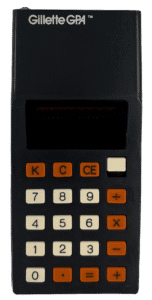
This black calculator was developed for Gillette, the razor company, as it explored entering the consumer electronics market. Known as the Gillette Personal Accountant (GPA), it offered basic arithmetic functions and an eight-digit LED display. Although short-lived, its design laid the groundwork for Sinclair’s Oxford range launched the following year. The moulded plastic casing was slightly rougher than later versions, but its internals and layout formed the blueprint for a new generation of affordable, British-made pocket calculators.
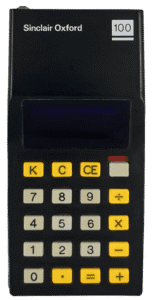
Introduced as the first model in the Oxford range, this black calculator offered four-function arithmetic with an eight-digit red LED display and a constant key for repeated calculations. It could be powered either by a standard 9-volt battery or plugged into the mains—useful for saving battery life during regular use. The Oxford 100 reused the design of the earlier Gillette GPA, but with a cleaner finish and improved casing, becoming a familiar entry point to electronic calculation in mid-1970s Britain.
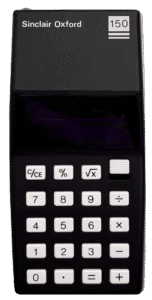
This black calculator added percentage and square root functions to the original Oxford 100 design, marking a small but useful upgrade for everyday calculations. It featured an eight-digit red LED display and algebraic input, and was powered by a standard 9-volt battery. Housed in a rounded case typical of later Oxford models, the 150 represents the incremental expansion of Sinclair’s calculator range as it sought to balance low-cost design with added functionality for home and office users.
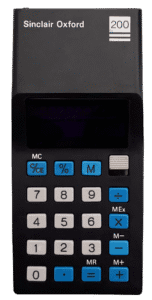
This early Oxford 200 model features a red LED display and offers memory and percentage functions—two upgrades over the more basic Oxford 100. It shared the same size and power source as other calculators in the range, using a 9V battery or mains adaptor. Launched in 1975, it reflected Sinclair’s aim to balance functionality with affordability in a fast-changing market.
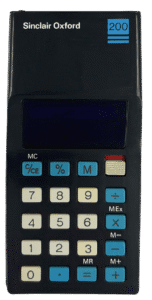
Identical in function to other Oxford 200 models, this version features a distinctive blue “200” model number printed at the top right of the casing—a subtle variation within the Oxford range. At almost twice the price of the Oxford 100, it offered useful extras like memory recall. This model retained its red LED display, and its compact design made it a practical choice for home or office use.

Later examples of the Oxford 200 switched from red LED to green vacuum fluorescent displays, which were easier to read in low light. This change echoed broader trends in calculator design during the mid-1970s. Despite its updated display, the model retained its key features—basic operations, memory, and percentage—powered by a single 9V battery or mains adaptor.
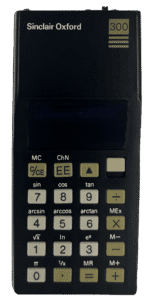
This scientific calculator brought advanced trigonometric functions—like sine, cosine and tangent—to a wider public at a much lower cost than most competitors. Its red LED display might indicate it as an earlier version within the 300 range. Although ideal for students and professionals, the Oxford calculators in general were known for draining their 9V batteries quickly. At the time, a specialist magazine even advised using a bulky battery for longer life—though this made the calculator too heavy for portability, effectively making it deskbound.
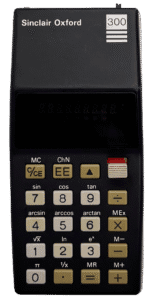
Designed for affordability and everyday use, this scientific model included functions like trigonometry and square roots. Its green vacuum fluorescent display made numbers easier to read, and a small switch at the top allowed users to toggle between degrees and radians—useful in science and engineering. A white “300” model number printed on the casing helped distinguish it within the Oxford range. Although more powerful than the Oxford 200, it shared the same short battery life.

An evolution of the Oxford 100, this white model included additional functions such as memory, percentage, square root, and reciprocal. Its green vacuum fluorescent display (VFD) offered better battery efficiency than earlier LED versions, reflecting a brief move toward lower-power alternatives before LCDs took over the market. The Universal was among the most advanced models in the Oxford range and represents Sinclair’s attempt to stay competitive as cheaper, more efficient Japanese calculators began to dominate.

This advanced model offered trigonometric, logarithmic, and exponential functions—tools essential for students and engineers. It featured an unusual top-mounted switch that let users toggle between degrees and radians, two different units for measuring angles. Its green vacuum fluorescent display (VFD) supported scientific notation and showed up to eight digits. Released near the end of the Oxford range, it reflected the growing demand for affordable scientific calculators in the mid-1970s
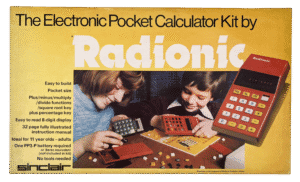
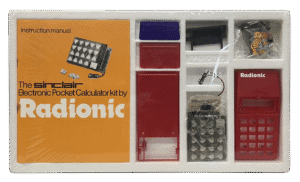
This build-it-yourself calculator kit invited young users to explore how everyday electronics worked—an early precursor to today’s STEM kits. Sold by Radionic Products Ltd., its design closely matches the Sinclair Oxford 150 and references Sinclair on the calculator’s packaging, suggesting shared components or manufacturing links. The finished calculator offered functions like percentages and square roots, all assembled without soldering—making technology hands-on and approachable for learners as young as eleven.
